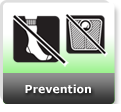Compression therapy is a well-known treatment and prevention method for venous insufficiency and deep venous thrombosis (DVT). For years, the method has somewhat been ignored but now is a basis for chronic venous and lymphatic insufficiency treatment. Tights, knee-length socks, stockings with graduated compression or bandages of various stretchability levels are used. Clinical experience and extensive literature prove the effectiveness of compression therapy in the treatment and prevention of venous insufficiency.
The application of elastic compression hosiery improves venous circulation, helps control venous hypertension and edema, and improves skin with ulcers or subcutaneous changes in the connective tissue. Compression hosiery in phlebology is divided by compression class in the ankle area (millimeters of mercury): Therapeutic compression hosiery is above 18 mmHg, while prophylactic products below 18 mmHg. According to international phlebologist forum experts, even a mild compression class is effective in reducing the symptoms of venous conditions. Compression stockings of 15 mmHg effectively reduce the heaviness of limbs, pain, edema and muscle cramps, and 18 mmHg compression at an ankle effectively reduces deep vein inflammation incidence rate during long-distance travel (the tourist class syndrome).
Compression therapy mechanism
Compression therapy is a specific compression on a lower limb gradually easing off upwards. Medical compression hosiery features a 3-class, graduated compression: 100% compression (declared on a packaging) at an ankle, 70% compression at a calf and 40% at a thigh.
Compression:
| • | decreases vein diameter and restores the activity of venous valves through bringing their cusps closer to each other |
| • | by reducing venous pressure, decreases blood reflux (blood backflow) |
| • | increases the speed of venous blood flow, and thus decreases hyperemia and blood content in subcutaneous capillaries |
| • | restores elasticity of vessel walls (if applied reasonably early) |
| • | reverses dysplastic changes in the middle coat of venous vessels (if applied reasonably early). |
Compression classes
Considering compression on the ankle (mmHg), we have 4 classes of therapeutic tutors (according to German RAL-GZ 387 standards). German standards have been approved by the European Standardization Committee and are applied by the best manufacturers in most European countries.
| • | CLASS 1 — from 18 to 21 mmHg |
| • | CLASS 2 — from 23 to 32 mmHg |
| • | CLASS 3 — from 34 to 36 mmHg |
| • | CLASS 4 — from 49 mmHg and above |






